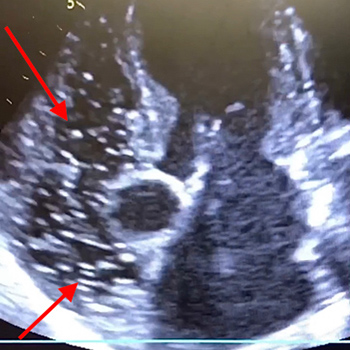Keywords
Aquarium sign, hepatic portal venous gas, acute mesenteric ischemia, bedside ultrasonography
Abstract
Objectives: The aquarium sign is the name given to a large quantity of bubble-like echoes that suggests the presence of hepatic portal venous gas (HPVG). Few studies in the literature have addressed the relationship between the aquarium sign and HPVG. In some cases, HPVG can only be detected using ultrasonography. HPVG can be observed in a variety of conditions, including those that require emergency surgery, such as acute mesenteric ischaemia (AMI). Therefore, it is important to identify the presence of HPVG as soon as possible.
Materials and methods: We report a case of the aquarium sign, where bubble-like echoes flowed from the right atrium towards the right ventricle, which was identified using bedside cardiac ultrasonography as part of a point-of-care ultrasound test.
Results: This aquarium sign finding led to the diagnosis of AMI, which was confirmed using contrast-enhanced computed tomography (CT).
Conclusion: The aquarium sign is a useful finding suggestive of HPVG and mesenteric ischaemia, which can be rapidly and easily observed using bedside cardiac ultrasonography. However, there are very few reports on the aquarium sign. The inability of other more cumbersome diagnostic imaging modalities, such as CT and magnetic resonance imaging, to detect HPVG emphasizes the utility and convenience of detecting the aquarium sign using bedside ultrasonography. This technique can lead to early detection of life-threatening diseases as well as improve the prognosis for patients. The diagnostic implications of the aquarium sign for HPVG are still unclear and require further research.
References











